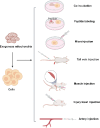Recent advances in mitochondrial transplantation to treat disease
- PMID: 40313574
- PMCID: PMC12041809
- DOI: 10.12336/biomatertransl.2025.01.002
Recent advances in mitochondrial transplantation to treat disease
Abstract
Mitochondrial transplantation (MT), an innovative regenerative technique widely used to treat diseases caused by mitochondrial dysfunction, shows great promise for clinical application. This procedure can increase the number of mitochondria and improve the function of damaged mitochondria, resulting in increased adenosine triphosphate levels, decreased reactive oxygen species production, improved Ca2+ buffering capacity, modulated inflammatory response, and reduced apoptosis to protect cells, thus promoting tissue repair. In this review, we describe research advances in MT over the last five years, focusing on its application in treating various diseases, including ischaemic injuries (of the kidney, heart, lung, and liver), neurodegenerative disorders, spinal cord injury, sepsis, diabetes mellitus, stroke, and ultraviolet radiation injuries, as well as in procedures such as organ transplantation, focusing on instances where MT demonstrated good efficacy. We also cover the application of engineered mitochondria and mitochondrial combination therapies and present the latest advances in improving MT efficiency, as well as the current clinical applications and shortcomings of MT, aiming to provide a theoretical foundation for enhanced MT utilisation in the future.
Keywords: cardiovascular diseases; ischaemia/reperfusion injury; mitochondrial dysfunction; mitochondrial transplantation; neurodegenerative diseases.
Conflict of interest statement
Conflicts of interest statement: The authors declare no conflict of interest.
Figures






Similar articles
-
Mitochondrial biogenesis: pharmacological approaches.Curr Pharm Des. 2014;20(35):5507-9. doi: 10.2174/138161282035140911142118. Curr Pharm Des. 2014. PMID: 24606795
-
Mitochondrial transplantation for the treatment of cardiac and noncardiac diseases: mechanisms, prospective, and challenges.Life Med. 2024 Apr 26;3(2):lnae017. doi: 10.1093/lifemedi/lnae017. eCollection 2024 Apr. Life Med. 2024. PMID: 39872662 Free PMC article. Review.
-
Structural integrity is essential for the protective effect of mitochondrial transplantation against UV-induced cell death.J Photochem Photobiol B. 2022 Sep;234:112534. doi: 10.1016/j.jphotobiol.2022.112534. Epub 2022 Jul 23. J Photochem Photobiol B. 2022. PMID: 35905626
-
Mitochondrial Transplantation: A Unique Treatment Strategy.J Cardiovasc Pharmacol. 2022 Jun 1;79(6):759-768. doi: 10.1097/FJC.0000000000001247. J Cardiovasc Pharmacol. 2022. PMID: 35639247 Review.
-
Melatonin and its protective role in attenuating warm or cold hepatic ischaemia/reperfusion injury.Cell Prolif. 2021 Apr;54(4):e13021. doi: 10.1111/cpr.13021. Epub 2021 Mar 10. Cell Prolif. 2021. PMID: 33751704 Free PMC article. Review.
Cited by
-
Causes of and Solutions to Mitochondrial Disorders: A Literature Review.Int J Mol Sci. 2025 Jul 11;26(14):6645. doi: 10.3390/ijms26146645. Int J Mol Sci. 2025. PMID: 40724895 Free PMC article. Review.
References
-
- Pernas L., Scorrano L. Mito-morphosis:mitochondrial fusion, fission, and cristae remodeling as key mediators of cellular function. Annu Rev Physiol. 2016;78:505–531. - PubMed
Publication types
LinkOut - more resources
Full Text Sources
Miscellaneous
